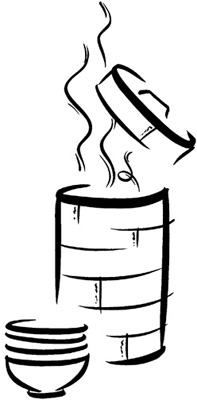
The first thing to understand about dim-sum—that genre of Chinese eating typified in the great pre-World War II tea houses of south China, but found in snack places in most every region—is that it is a phenomenon of a culture that was both fixated on the eccentricities of food and had a vast population at its disposal to pleat dumplings. In terms of kitchen labor, it is the culinary equivalent of making an eleven-course meal of dainty petit fours, each a studied contrast in color, texture, and flavor. Hence, the “and then some” of this chapter. For to keep sanity amidst the dumpling pleating, we threw in some larger foods—breads, turnovers, and noodle dishes!
An early attempt at China Moon to make a full luncheon menu of dim-sum and then some, nonetheless drove us batty. The customers were very enthusiastic, as long as they had a two-hour lunch, but the cooks and waiters went wild. Tiny dishes of this and that were the stuff of waking nightmares, and we all wished for immensely large plates of a single unwrapped food.
As things balanced themselves out over the years, the China Moon lunch and dinner menus came to feature several dim-sum items each. Won-ton were balanced out by comfortably large pieces of steamed fish, and the madness of bun-making was forgotten in the relief of a sparerib stew. This is a good thing to remember when planning a meal at home. Obsessive types will adore prostrating themselves before a menu plan of a dozen dim-sum. But most of us, myself included, would best plan a salad with their springrolls.

Here, then is a chapter full of very delicious little items. They are truly among the most memorable of dishes to emerge from the China Moon kitchen. I dedicate them to the millions of hands that have pleated, rolled, and wrapped such savory tidbits throughout China’s long and luscious history, inspiring all of us who follow blissfully and blindly in their wake.